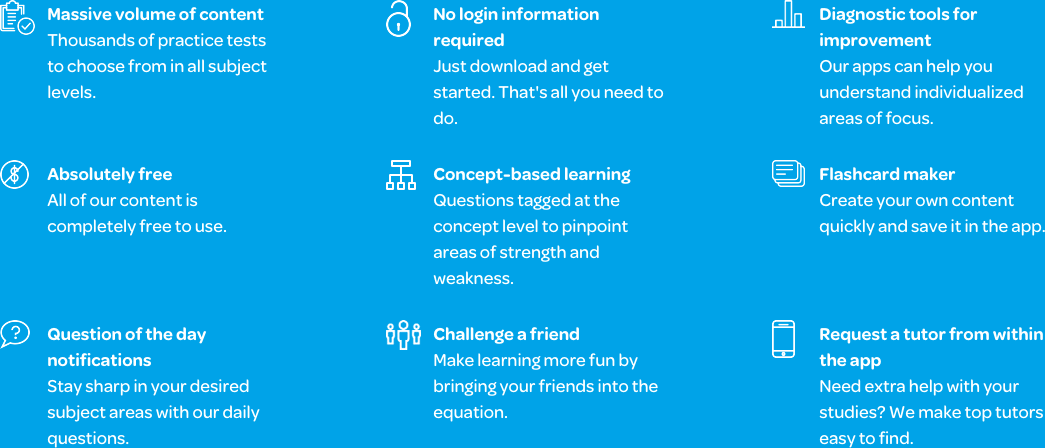The Varsity Tutors SAT II US History Mobile App
Formerly known as the SAT II US History test, the SAT Subject Test for US History is perfect for high school students who want to showcase their passion and dedication to US History. Students who are ready to take their interest in history to the next level should download the Varsity Tutors SAT Subject Test for United States History app for iPhone, iPad, and Android devices. This app can help you along your way as you work toward achieving an excellent score on the test.
The Learn by Concept tool on the free SAT US History app is well-organized to aid you in focusing your studies. The app takes a logical approach to learning. The subject categories include US Economic History, US Foreign Policy, US Intellectual and Cultural History, US Political History, and US Social History. Each of these overarching subjects are arranged into three time spans: pre-Columbian history through 1789, 1790 to 1898, and 1899 to the present.
Topics included in each category and time period include the cause and effect of specific events in US history, facts and details of the historical time period and subject, and the sequence and summary of the subject and time period in history.
The section on representative viewpoints is particularly significant. This section provides you with passages that were written or spoken by important figures in history. You must identify its speaker or author. This is just one way the test integrates the recognition of historical figures with their positions on a variety of topics.
All of the app’s resources help to prepare you for the 60-minute, 90-question SAT US History Subject Test. Though you will need to memorize facts, you must also demonstrate your understanding of cause and effect relationships. You will also have to prove your ability to interpret historical knowledge through charts, graphs, cartoons, and maps.
To begin your preparation, you might want to take one of the full-length, timed practice tests. This section of the app will give you questions that are just like the ones you’ll see on test day. Not only does it test your knowledge, but it provides opportunities for you to learn. For every question you encounter, you’ll receive a detailed explanation of the right answer.
Once you know your strengths and areas of need, you can move on to the flashcards or the Learn by Concept resource to review specific subjects. Both of these tools are organized from broad topics to specific concepts, so if you need to remember the details of the 1765 Stamp Act, you will be able to find it. You can even use the Flashcard Maker to create custom flashcards, including your own images, audio, and text to personalize your learning experience.
After you have done a thorough review, take another practice test to see how you have progressed. You can keep track of all the tests you take, and you can repeat this process as many times as you wish.
Download the Varsity Tutors SAT Subject Test for US History app today from iTunes or the Google Play Store, and begin working towards a great score on test day!
66 mobile apps to choose from for your tutoring needs.

Learn More
If you are a high school student who is planning on going to college, you might want to take an SAT Subject Test administered by the College Board. While these tests don’t earn you college credits, they can improve your chances of being accepted to a top university. Moreover, they can also help you with placement, as well as give the faculty an idea of your proficiency level.
If you are interested in studying a degree program related to history or humanities, you should consider taking the SAT Subject Test in United States History. This test, which was known as the SAT II U.S. History Test until 2005, evaluates your understanding of the people and events that have shaped the United States as we know it . It is the second most popular SAT Subject Test taken, just behind the Subject Test in Mathematics Level II.
The test is made up of 90 multiple-choice questions, which you have one hour to complete. Each question gives you five answers to choose from. The test covers the social, economic, and political history of the United States. You will be quizzed on the history of America, from the Pre-Columbian era up until the present.
To do well on the SAT U.S. History Test, you are required to know about the extensive history of the North American continent, starting with the first humans who migrated to America through the Bering Strait 15,000 years ago. During this Pre-Columbian time period, various nomadic groups traveled across the continent until they eventually settled. Upon settling in permanent locations, they learned to farm and began to develop unique cultural identities, including languages and customs. Each major group became a separate tribe, and every tribe adapted to their region.
The effects of Christopher Columbus’ explorations are also required knowledge for this test. When Columbus landed in the New World, Spain was a global superpower. Spanish and French dominated the exploration of the Americas for nearly 100 years, until the British defeated the Spanish Armada in 1588. This victory shifted power to the British, who began colonizing North America. You should note that initially, the British did not enforce colonial law in fear of the settlers joining the French side. However, by the mid-1700s, Britain was feeling the financial effects of a war with France, and began taxing the American settlers. This is one of the motivating factors behind the Revolutionary War.
It is important that you have a working knowledge of other events that led up to the Revolutionary War as well. This includes the philosophy of political thinkers like John Locke, who believed that the British crown was impeding on the colonists’ natural rights. Furthermore, you should know that, after the war, the Articles of Confederation were created because the state powers viewed a strong central government as a threat to freedom.
As you learn about the early history of the United States, you should know about the controversy that surrounded the Constitution. Specifically, how the New England Federalists argued that it should act as a loose guideline, whereas the Southern Republicans demanded that it be strictly enforced. Another key point to note is how the United States worked hard to remain neutral in international conflicts until the War of 1812, when they clashed with the British again. Other important themes of this time period are the Monroe Doctrine, the Louisiana Purchase, and the Missouri Compromise.
When learning about America in the early-to-mid 1800s, take note of the conflicts that created the Democratic and Republican parties. This is also the time when Andrew Jackson was elected president. You should be familiar with the criticism behind his presidency, as well as the Nullification Crisis, which almost led to serious conflict over federal versus state power. Additionally, know about Manifest Destiny, the belief that the American government had the right to expand its borders.
By the time you get to the Civil War period, you should know the factors that influenced the war. You should also be familiar with Lincoln’s reconstruction plan, and how that was changed after his assassination. Additionally, you should know the importance of the following time period, the Industrial Revolution. This is when large scale business emerged in America, and is how industrialism in the New World brought many European immigrants. Moreover, this time period was associated with political parties being influenced by big business until 1883, when the Pendleton Act was passed.
It is also important to note the shift in American policy prior to the Spanish-American War, when the government took a more imperial approach. As you study World War I, note that America originally wanted to stay neutral. Also, you should be familiar with the League of Nations, and understand how it functioned as a predecessor to the United Nations.
The 1920s were an interesting time in American history. Known as the “Roaring Twenties,” it was seen as an age of success and progressivism. You should note the cultural movements of the period, including the prohibition amendment, and take note of the events that led up to the Great Depression. You should know about Black Thursday, as well as Franklin D. Roosevelt’s New Deal, which is credited by many with pulling the country out of the depression.
As you learn about the Great Depression, remember that it was the global economic effects of it that gave rise to European fascism, which caused World War II. You should know about the Treaty of Versailles and how it affected Germany, and you should become familiar with the battles in the European and Pacific theaters. The other important time periods following the war that you should know about are the Cold War and the Civil Rights movement.
As you learn more about present-day America, you should learn about the Vietnam War and the protest movements of the 60s that happened as a result. Also, it is important to note that the end of the Cold War in 1989 resulted in the fall of the Soviet Union.
By reviewing these key time periods, you can better prepare yourself for the SAT Subject Test in U.S. History. The questions on the exam may be presented in tables, graphs, pictures, and maps. The majority of the content is similar to what is taught in high school history courses.




